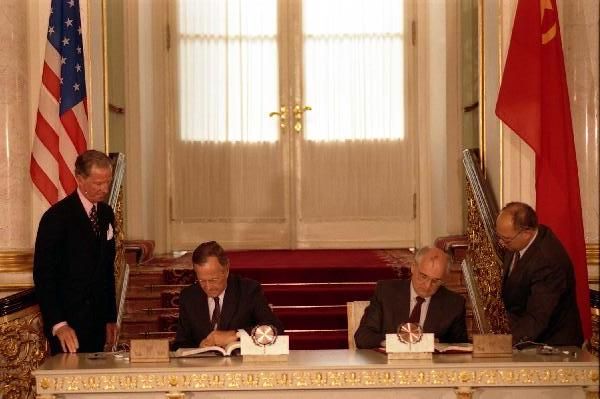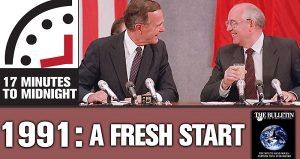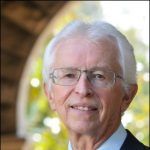George H.W. Bush worked toward a soft nuclear landing for the dissolving Soviet Union
By Siegfried S. Hecker | December 4, 2018
 George H.W. Bush and Mikhail Gorbachev sign the Strategic Arms Reduction Treaty (START) in 1991.
George H.W. Bush and Mikhail Gorbachev sign the Strategic Arms Reduction Treaty (START) in 1991.
My tenure as director of the Los Alamos National Laboratory from 1986 through 1997 overlapped the presidency of George H.W. Bush. His tenure witnessed momentous changes around the world that included the breakup of the Soviet Union. As director of the laboratory, I had a front-row seat to the unfolding of the events that led to the collapse. From what I saw, President Bush never got due credit for the steady hand on the tiller he provided during this tumultuous time. I want to pay tribute to his presidency by recalling several key events that directly affected my life.
On September 27, 1991, President Bush launched what we now call the Presidential Nuclear Initiatives with a phone call to Soviet President Mikhail Gorbachev. That conversation, recently declassified, begins: “Mikhail, how are you?” Gorbachev replied: “George, hello. I received your letter. I very much want to talk.”
A phone call was one of President Bush’s favorite means of conducting quiet diplomacy. Few calls in his presidency were of greater importance than this one. On nationwide TV at 8:30 that evening he told the American people that the United States would unilaterally eliminate and stand down a host of nuclear weapons. The call to Gorbachev was to give him a heads up and ask him to consider reciprocal actions. It was done in Bush’s typical pragmatic fashion to give Gorbachev some breathing room as he dealt with nuclear dangers in a failing Soviet Union.
Gorbachev asked, “You are doing these steps unilaterally, and you call on us to consider our steps, is that right?” “Yes, correct,” replied Bush, and went on to specifics: “On dismantling nuclear warheads, where I propose we open discussions on the safe dismantling of nuclear warheads, on how we might enhance the safety and security of nuclear weapons, and how to improve nuclear command and control—I’d like to say you and I agree that this would be a good thing to do.”
Gorbachev replied: “George … since you’re urging that we take steps, I can only give an answer in principle—since there is much that must be clarified—and that answer is a positive one.” Gorbachev added, in closing: “Thank you. I want again to congratulate you on this major proposal. It is a historic initiative, comparable to Reykjavik.”
The next day, Defense Secretary Dick Cheney directed the secretaries of the military branches and the Chairman of the Joint Chiefs of Staff to implement the president’s directive to reduce the United States nuclear arsenal as soon as possible. The required actions included the elimination of the inventory of ground-launched theater nuclear weapons; the removal of tactical nuclear weapons from all surface ships, attack submarines, and land-based naval aircraft bases; the standing down of US strategic bombers from their alert postures and removal of their nuclear weapons to storage in secure areas; and the termination of the mobile Peacekeeper ICBM rail garrison system.
On October 5, Gorbachev announced in a nationwide Soviet TV address that he would take reciprocal actions. Bush and Gorbachev had signed the Strategic Arms Reduction Treaty (START) calling for reductions in strategic nuclear arsenals only a few months before, but it was Bush’s phone call that led to what David Hoffman in his 2009 book, The Dead Hand, called “the most spontaneous and dramatic reversal of the Cold War arms race.”
President Bush’s proposals to cooperate on nuclear warhead dismantlement, to enhance the safety and security of nuclear weapons, and to improve nuclear command and control were aimed at tackling the new nuclear dangers brought to light by the attempted August 1991 coup against Gorbachev by Soviet hardliners. Gorbachev was placed under house arrest in his dacha in Crimea and relieved of control of the nuclear briefcase—the launch codes for Soviet nuclear weapons.
Three days later, the coup had failed, and Gorbachev returned to Moscow. But both Gorbachev’s days as president and those of the Soviet Union itself were numbered. On December 25, Gorbachev dissolved the Soviet Union into 15 independent states. The Soviet break-up was the first time in history that a country with the capacity to destroy the world—with tens of thousands of nuclear weapons, over one million kilograms of fissile materials that could fuel bombs, hundreds of thousands of nuclear workers, and a huge nuclear complex—had been thrust into political and economic chaos.
The specter of another Chernobyl nuclear accident, of nuclear weapons and nuclear materials winding up in Iraq, Iran, or North Korea, or of a nuclear environmental disaster haunted Washington. The international community feared for the fate of Soviet nuclear weapons, the security of its nuclear materials and facilities, a brain drain resulting in potential leakage of nuclear weapons expertise abroad, and the possibility of dangerous nuclear exports to raise revenues. Bush’s unilateral reductions in the US nuclear arsenal would give Gorbachev the opportunity to reduce his stockpile of vulnerable nuclear weapons and materials.
Fortunately, in the fall of 1991, both countries had visionary leadership by dedicated professionals in government, nongovernmental organizations, and academia to help usher them through these uncertain times. On December 12, 1991, President Bush signed into law the “Soviet Nuclear Threat Reduction Act of 1991.” The Nunn-Lugar program, named for its primary sponsors, Senators Sam Nunn and Richard Lugar, provided the vision, funds, and guidance for US-Soviet nuclear cooperation for the next two decades.
For me, these were also consequential times. I had been in contact with Soviet nuclear weapon scientist counterparts since August 1988. As a result of the October 1986 Reagan-Gorbachev Reykjavik Summit, the nuclear laboratories were directed to conduct reciprocal nuclear tests at each other’s test sites and allow for on-site verification to gain the confidence needed to ratify the 1974 Threshold Nuclear Test Ban Treaty.
After the reciprocal nuclear tests on Aug. 17, 1988, at the Nevada Test Site and Sept. 14, 1988, at the Soviet Semipalatinsk Test Site, we nuclear scientists from the two countries tried to convince our governments that it was time to meet and cooperate on emerging new nuclear dangers, namely the safety and security of nuclear weapons and materials and concerns about nuclear proliferation and terrorism.
A breakthrough in my attempts to convince Washington came on Dec. 16, 1991. Energy Secretary Adm. James Watkins came to a retreat of Energy Department laboratory directors in Leesburg, Virginia, straight from a cabinet meeting with President Bush. The president had expressed great concern about the possibility of a brain drain from the Soviet nuclear complex and the proliferation of nuclear weapons knowledge.
Watkins asked us, the lab directors, for suggestions of what could be done to keep Soviet nuclear scientists at home. Since I had been working with his staff for a year to get approval for a US-Soviet laboratory directors’ exchange, I said, “Why don’t we go ask the Russian laboratory directors?” Watkins responded immediately: “Why don’t you?”
In less than two months, John Nuckolls, director of the Lawrence Livermore National Laboratory, and I found ourselves inside the Russian closed nuclear cities. We got an unprecedented look into the Russian nuclear complex. This visit launched US-Russian lab-to-lab cooperation, and for me it was the first of 56 trips to Russia. During the first post-Soviet decade, my efforts were directed at helping the Russian nuclear complex with what we called the four loose nuke problems—loose nuclear weapons, loose nuclear materials, loose people, and loose exports. In recent years, my main focus has been on collaborative efforts to continue cooperation in the never-ending quest for improved nuclear safety and nuclear security.
President Bush’s Secretary of State, James A. Baker, visited one of the Russian nuclear weapons centers weeks before our trip to propose a joint International Science and Technology Center to help the Russian nuclear weapon scientists make a transition to the post-Cold War era. Although that initiative and other cooperative threat reduction initiatives progressed only slowly during Bush’s final year in office, it was his realistic and well-informed grasp of global politics that guided the United States through the dissolution of the Soviet Union and the end of the Cold War and fostered the type of environment where the lab-to-lab cooperation could succeed.
Bush’s decisions on nuclear testing also had a great impact on my activities at Los Alamos. Despite his earlier opposition to the August 1992 Nuclear Testing Moratorium Act, President Bush signed the Hatfield Amendment establishing a US nuclear test moratorium on Oct. 2, 1992. I was in Washington shortly after Los Alamos conducted this country’s last underground nuclear test on Sept. 23, 1992. I was told President Bush had decided to sign the moratorium, but that it would allow for a limited set of up to 15 tests to ensure the reliability and safety of US nuclear weapons before the United States would plan to conclude a comprehensive nuclear test ban treaty (CTBT). Bush also announced that the United States would not build nuclear weapons with new military capabilities.
On my return to Los Alamos, I told our employees that our world had just changed inexorably. We must prepare to do our job of nuclear weapon stockpile stewardship without nuclear testing, I told them, because I believed the nuclear testing days were over. With the advent of the Clinton administration in January 1993 and Clinton’s support of the CTBT, my predictions turned out to be correct. President Clinton signed the CTBT on September 26, 1996 (though it is yet to be ratified by the US Senate).
Although President Bush was not a fan of the test moratorium or of the CTBT, he took a pragmatic approach, agreeing to the moratorium because the test ban had strong congressional support at the time. His nuclear policies were similarly practical, reflecting the geopolitical changes ushered in by the end of the Cold War.
Although President Bush’s time ran out with the election of Bill Clinton, he left an impressive legacy of having guided this country and the world through a transition in global affairs that was as remarkable as it was unexpected. As so many others have remarked, he was a statesman who served his country with distinction and was one of the most genuinely decent individuals ever.

The actions of Bush and Gorbachev in 1991 resulted in the largest step back from nuclear midnight ever marked on the “Doomsday Clock” of the Bulletin of the Atomic Scientists. At that time, it was placed at 17 minutes to midnight. Today it stands once again at its most perilous—2 minutes to midnight—waiting for a new generation of enlightened leaders to once again seek a real reduction in global nuclear dangers.
Together, we make the world safer.
The Bulletin elevates expert voices above the noise. But as an independent nonprofit organization, our operations depend on the support of readers like you. Help us continue to deliver quality journalism that holds leaders accountable. Your support of our work at any level is important. In return, we promise our coverage will be understandable, influential, vigilant, solution-oriented, and fair-minded. Together we can make a difference.
Keywords: Cold War, Gorbachev, Nunn-Lugar
Topics: Nuclear Risk, Nuclear Weapons
















Credit should always be given where it is due. George Bush senior ‘left an impressive legacy of having guided this country [the US] and the world through a transition in global affairs that was as remarkable as it was unexpected.’ It brought an end to a very dangerous period of world history. But today we are in an even worse environment. While tensions were very high during the Cold War, nuclear holocaust did not occur. That is because the Cold War was the peace. The world has experienced periods of peace (or relative peace) throughout history. The Thirty Years Peace… Read more »
There must be an international effort to convince countries with nuclear weapons to disarm their weapons by convincing them that even a limited nuclear weapons exchange between two countries will not lead to a victory on either side of the war and will endanger the survival of all life on this planet. This demand for nuclear disarmament should begin at the grass roots level. The United States and Russia should lead the way forward. International Atomic Energy Commission should form an international law enforcement network that has access to anyplace on the planet to check for nuclear weapons production and… Read more »
The $5 trillion boondoggle of nuclear weapons and delivery systems development cannot be undone because the United States and other nations to which their creations of mass destruction have proliferated will never renounce their use and mothball the complex that has employed Hecker and his colleagues for three quarters of a century. With Trump re-igniting the arms race, and politicians like former Texas governor Rick Perry redirecting the Department of Energy from important tasks like Global Warming prevention to installing intermediate-range nuclear weapons in Europe, the Bulletin should use the remaining two minutes to enlighten us, rather than praising the… Read more »
Not so good on many other fronts—Iraq!, Chile (Letellier assassination) , invasion of Panama, the Iran-Contra affair (pardoning of Weinberger and others ), and others. He had dirty hands as head of the CIA. Not to speak of domestic matters, such as his twisted stand on abortion.
Praiseworthy, indeed. Also, worthy of more attention were the negotiations that lead to Kazakhstan, Belarus, and Ukraine delivering the nukes on their territorities to Russia for dismantlement (one of the few — only — cases of mutually verified dismantlement in the Nuclear Age). It is disappointing in the extreme, that Russia violated its agreement with Ukraine in order to annex Crimea. As I recall, Bush agreed to the Hatfield amendment because it was attached to a bill that allocated funds for a superconducting cyclotron in Texas. In signing that bill, he explicitly pledged to overturn the moratorium once re-elected. Is… Read more »